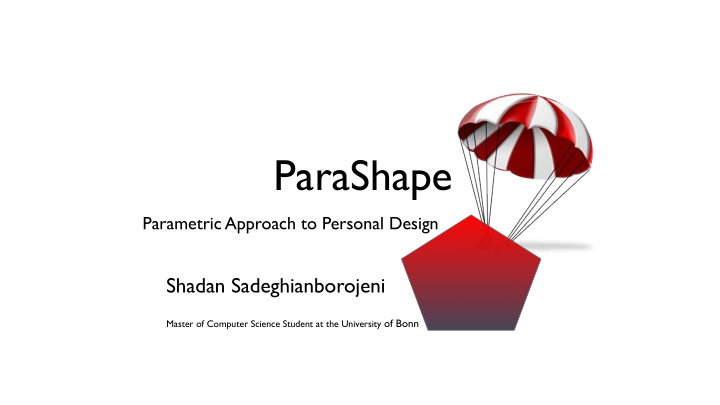



ParaShape Parametric Approach to Personal Design Shadan Sadeghianborojeni Master of Computer Science Student at the University of Bonn
Motivation ? 3D Idea Print Model
Who is the User? Novice User Expert User
Initial Survey Expert Users Novice Users • Use WYSIWYG CAD • Use pen and paper and to visualize design ideas to visualize design ideas (AutoCAD) • Think more • Like composing parts functionalities and to make complex objects learnability makes a tool • Spend minimum 30 usable • Spend minimum 30 minutes on a design minutes on a design visualization visualization
Related Work •
Related Work (Problems) CAD 3D Creators/Customizers 3D model libraries • Static models, 3D modeling • High learning curve • Small range of object models skill required for customizing covered • Complex UI
Requirements s H l e d i o g m h D 3 r t e c e a j C b d o a f a o p b e a g i n b l a i r i t h l y g High flexibility of the existing 3D models for customization i i t H o y f o 3 f D c o m d Understandable interface o e d r e e l u c s o e d e Easy and fast search and browsing for the models Understandable units of measurement High learnability of the system Capability of making complex 3D models without having 3D modeling skill m e t s y s e h t f o y c n e i c i f f e e m i T
Makerbot Customizer • Met 5 out of 10 of our system requirements • Low system usability scale (52%) • Users feedback not satisfactory
Hypotheses of ParaShape Component-based Modeling Primitive Instancing of Components Units of Measurements Component Code Templates
H1:Component-based Modeling Every object is made of its composing components
H2: Primitive Instancing of Components
H3: Units of Measurement • Metric Units: a cylinder with a cross section radius of 10 millimeters and height of 44 millimeters • Market Units: AAA battery 76% rated the market units of measurement as a more acceptable system: is more familiar, prevents measurement errors
H4: Component Code Templates Increases 3D model code readability Supports 3D model code reuse Prevents errors
Paper Prototype • Qualitative user study • Separate questionnaires for both user groups • Comments and suggestions used as requirements for final mockup
Mockup
Mockup
Evaluation of Mockup • PSSUQ Results • Hypotheses Verification H1: Component-based modeling Overall 85% H2: Primitive instancing of components SysQual 86% H3: Units of measurement InfoQual 87% H4: Component code templates IntQual 88%
Future Work • Implement a working system of ParaShape • Evaluate the system with 3D printers • Using other interaction techniques (digital pen, virtual clay, etc.) • Prevent 3D printing mistakes ( printability of the model, ergonomics, cost)
Conclusion • The goal of personal design is to make everyone able to turn their ideas into physical objects. • ParaShape proved that by using the knowledge of experts, we can make almost everyone able to make complex 3D models needless of having 3D modeling background.
Thank you!
Recommend
More recommend